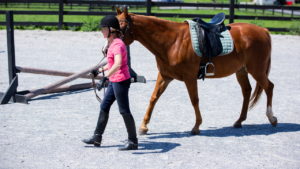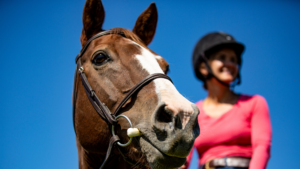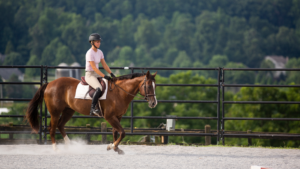Learning to ride is a lifetime journey. There is always more to be discovered and mastered.
As with any learning process, the deeper we go, the more we recognize there is no one “right way” to do anything. Instead, there are layers of subtlety in our skills and choices in our techniques that we develop along the way.
Today, I want to share a technique that is often skipped over in basic riding instruction. It is a technique for moving with the horse through transitions, for staying fluid and in balance and encouraging the horse to do the same.
It may seem contrary to what you have been taught, but try it out and consider it an extra option in your skills.
In down transitions, especially rising trot to walk, most riders think they need to sit down and stop rising to ask for the transition – but this can result in a braced rider and a hollow backed, bracing horse. Not a good combination for a smooth and effortless transition.
In this video, I will show you how to keep rising the trot, for smoother transitions into walk and into canter.














42 Responses
Wow! This looks awesome except I can’t imagine my horse slowing down for that little change in movement. My horse really likes to be fast, and I’m a pretty new rider, so my instructor will tell me to “pull her teeth out” to get her to slow down. I’ve tried stopping her off my seat (I can do this on other horses sometimes) and nothing, so I’m not sure slowing posting would have an impact?
Julia, I think how your seat is functioning during the transition is going to be really important for you to keep in mind but definitely give this exercise a try!
-Julia, HorseClass Community Manager
Love this explanation. I’d like to know more tips for transitioning down from canter to trot. I struggle to keep my horses’s head from flying up and for me to be more balanced when I ask for trot from canter.
Hi Callie,
I SO enjoy your training and guidance in better horsemanship.
I appreciated this video on smooth transition because this is an area I struggle.
Not complaining, however, would it be possible to demonstrate like you did, and then run it again in slow motion…(I’m old – 73!). And if your videos were a wee longer, well 🙂
We appreciate your feedback Bonnie! We go over this concept, along with the fundamentals of a balanced riding position, in our Balanced Riding Course.
-Julia, HorseClass Community Manager
Thanks Callie, I often struggle to achieve a smooth transition for exactly the reasons you said and a few times have stayed rising as you suggested and it was easier but I felt like I was doing something wrong because the teaching I had had always said you had to sit!(even tho it felt bad!) I would like to get some instruction for getting the smooth change of direction in serpentine please.
Hi Kate, Callie covers that plus 66 other exercises in her Stay in the Saddle book. You can get a copy by clicking here.
-Julia, HorseClass Community Manager
Thank you. So glad you showed that as I do as you suggest, quite naturally with my horse & find transitions never unbalance him. He has great self carriage, so it it easy to move accordingly.
Do enjoy your wonderful nuggets of ‘common sense’ when riding. We can all so often forget.
Tania, I’m glad you enjoyed the video!
-Julia, HorseClass Community Manager
Very applicable and learnable—works great , particularly on hot horses. I have used this for a number of years– the slower posting also can control the pace of the trot–faster posting can increase the pace
Callie, I loved this lesson. I have been doing this both transitioning from trot to walk and trot to canter. I thought I was being a little lazy because I honestly was not taught to sit at both transitions.
Thank you for permission and stating what my 60 year old body preferred.
Thank you Callie.
My coach frequently reminds me to relax my braced ankles. I seem to return to this bracing every time I’m not focusing on not bracing. Can you help me to relax the lower leg in a natural way?
Thanks so much. My book just arrived and it’s terrific.
Eleanor, absolutely! Check out this video on developing a steady lower leg to help you find more stability in the saddle.
-Julia, HorseClass Community Manager
I have an issue keeping my hands still
Nancy, I’d love to have you check out this video on developing steady hands to help you with this 🙂
-Julia, HorseClass Community Manager
Thanks, I like this idea. When working with my young horse, he interprets when I go from posting trot to sitting, that I am asking him to canter (which sometimes I am)! This may help clarify to him, whether I am asking for walk or canter. Thanks again for a good idea.
Sarah, I hope these tips are helpful! It sounds like he might be anticipating the canter transition.
-Julia, HorseClass Community Manager
Hi! I’d love help with the best cues to get the correct lead at canter.
Thank u!
Love your videos. Lots of great info!
Gretchen, there could be several factors affecting the canter lead issue. You can click here to watch a video for some guidance 🙂
-Julia, HorseClass Community Manager
Love your videos Callie. First time anybody has suggested this. Well done. Cannot wait to try it out.
Hope Callie’s tips are helpful Jacquie!
-Julia, HorseClass Community Manager
Enjoyed video, good clear advice / help
Really glad you liked the video Sue!
-Julia, HorseClass Community Manager
Love your videos, Callie! I am excited to try this technique on Monday. Thank you so much and Happy Spring 🌷
Happy practicing Carly!
-Julia, HorseClass Community Manager
This is great timing for me – and m working on transitions and had never heard of this approach. And one of my horses has a tendency to hollow her back so this will be very helpful!!!
This will be super helpful for you and your horse Andy 🙂
-Julia, HorseClass Community Manager
So enjoy your posts. You do a fantastic job communicating and demonstrating.
Thanks for your kind words Karen!
-Julia, HorseClass Community Manager
Thank you Callie! I’m working on transitions now with my young gelding so this is perfect! Love all of your videos!!
Glad you enjoyed the video Dawn!
-Julia, HorseClass Community Manager
Thanks Callie. I’ve always struggled with transitions especially as my horse and I are not balanced. We always have a horrible trot to canter transition so I’m going to try this tip to see if it helps us 🙂
Let us know how it goes when you give it a try Claire!
-Julia, HorseClass Community Manager
I’d like to see transition and riding the canter. When I was a teenager it was no problem. Now I’m older and getting back into riding and I feel like I’m fighting it but don’t know how to correct it.
Joy, you can click here to watch a video with tips on riding the canter and then also check out this video on the canter transition!
-Julia, HorseClass Community Manager
I need some help with my downward from canter to trot. my horse is very good from trot to walk. so it is probably in the message i am sending to him
Hi Joanne, what seems to be the challenge with the canter to trot transition? Does he lose balance?
-Julia, HorseClass Community Manager
I-would love to hear how “to ride the hind end” how to “feel the power, impulsion coming from the “ rear wheels first?
Hi Kathi, click here to watch a video for an explanation on this from one of our instructors Angelo Telatin.
-Julia, HorseClass Community Manager
I would like to work on having more confidence in the relationship I have with my horse..he has never really done anything more spook a few seconds at random things or once on a trail he got a little huffy when he lost sight of the other horses, but I’ve develop a fear of asking for the canter….I can canter on the 25 year old school horse because I have more confidence that he won’t do anything crazy…but I somehow can’t make
Myself ask on my horse..I’m 60…have never fallen off and I really don’t want to add that as an option because I’m afraid I’ll quit if I do
The posting request for canter is a new idea for me. I have a green horse and we’re still introducing a ridden canter, nevermind requesting specific leads. How does the posting diagonal and associated timing (asking when your bum touches down or when you’re a bit extended in the post) affect how the rider requests the transition to canter and ensure you don’t confuse the horse as they learn to identify specific leads in the canter request?
Kate, the cue for the correct canter lead comes from the outside leg asking for the canter rather than the rider’s seat as well as the bend of the horse’s body.
-Julia, HorseClass Community Manager